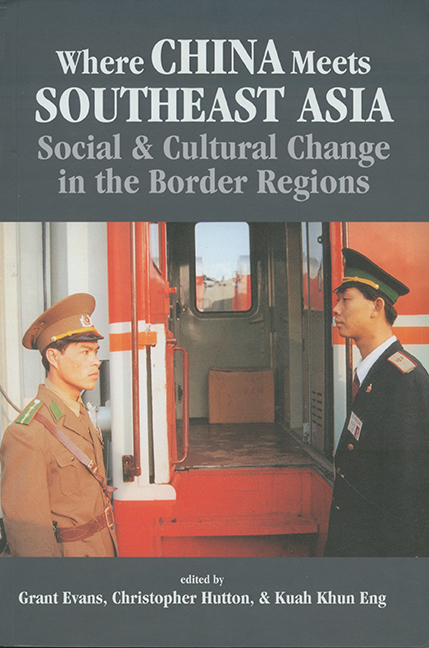Book contents
- Frontmatter
- Contents
- Contributors
- Map
- Introduction: The Disappearing Frontier?
- 1 Where Nothing Is as It Seems: Between Southeast China and Mainland Southeast Asia in the “Post-Socialist” Era
- 2 The Southern Chinese Borders in History
- 3 Ecology Without Borders
- 4 Negotiating Central, Provincial, and County Policies: Border Trading in South China
- 5 The Hmong of the Southeast Asia Massif: Their Recent History of Migration
- 6 Regional Trade in Northwestern Laos: An Initial Assessment of the Economic Quadrangle
- 7 Lue across Borders: Pilgrimage and the Muang Sing Reliquary in Northern Laos
- 8 Transformation of Jinghong, Xishuangbanna, PRC
- 9 The Hell of Good Intentions: Some Preliminary Thoughts on Opium in the Political Ecology of the Trade in Girls and Women
- 10 Cross-Border Mobility and Social Networks: Akha Caravan Traders
- 11 Cross-Border Links between Muslims in Yunnan and Northern Thailand: Identity and Economic Networks
- 12 Trade Activities of the Hoa along the Sino-Vietnamese Border
- 13 Cross-Border Categories: Ethnic Chinese and the Sino-Vietnamese Border at Mong Cai
- 14 Regional Development and Cross-Border Cultural Linkage: The Case of a Vietnamese Community in Guangxi, China
- 15 Women and Social Change along the Vietnam-Guangxi Border
- Index
7 - Lue across Borders: Pilgrimage and the Muang Sing Reliquary in Northern Laos
Published online by Cambridge University Press: 21 October 2015
- Frontmatter
- Contents
- Contributors
- Map
- Introduction: The Disappearing Frontier?
- 1 Where Nothing Is as It Seems: Between Southeast China and Mainland Southeast Asia in the “Post-Socialist” Era
- 2 The Southern Chinese Borders in History
- 3 Ecology Without Borders
- 4 Negotiating Central, Provincial, and County Policies: Border Trading in South China
- 5 The Hmong of the Southeast Asia Massif: Their Recent History of Migration
- 6 Regional Trade in Northwestern Laos: An Initial Assessment of the Economic Quadrangle
- 7 Lue across Borders: Pilgrimage and the Muang Sing Reliquary in Northern Laos
- 8 Transformation of Jinghong, Xishuangbanna, PRC
- 9 The Hell of Good Intentions: Some Preliminary Thoughts on Opium in the Political Ecology of the Trade in Girls and Women
- 10 Cross-Border Mobility and Social Networks: Akha Caravan Traders
- 11 Cross-Border Links between Muslims in Yunnan and Northern Thailand: Identity and Economic Networks
- 12 Trade Activities of the Hoa along the Sino-Vietnamese Border
- 13 Cross-Border Categories: Ethnic Chinese and the Sino-Vietnamese Border at Mong Cai
- 14 Regional Development and Cross-Border Cultural Linkage: The Case of a Vietnamese Community in Guangxi, China
- 15 Women and Social Change along the Vietnam-Guangxi Border
- Index
Summary
The Muang Sing reliquary is known locally as Thaat Muang Sing or Thaat Chiangteum. It is situated at the top of Doi Chiangteum mountain about 4 kilometres southeast from Muang Sing town, the market and administrative centre of Muang Sing district, Luang Namtha province, northern Laos. The reliquary has long been venerated by the Tai Lue and Tai Neua people of Muang Sing and by the Tai Lue of the neighbouring area of Xishuangbanna in China. There are twenty-six Lue and five Neua villages in the Muang Sing district, with all but three being located in the fertile Muang Sing valley where wet-rice cultivation is the dominant form of agriculture. The surrounding mountains are inhabited by non-Buddhist Akha and Yao tribes dependent on swidden cultivation of dry rice and opium.
The aim of this chapter is to explore several issues with reference to the Thaat Chiangteum reliquary of Muang Sing. These are:
• the relation between Buddhist universal values, as represented in pilgrimage, and moral communities which cut across political boundaries;
• the effect of physical factors (for example, geographic distance, terrain, and transport) and political factors on pilgrimage, particularly in the post-socialist context of the “open-door” policy in the central Mekong region;
• the relation between the Muang Sing reliquary and the mission of the contemporary charismatic Buddhist saint, Khruba Bunchum Yaansuamro, and his role in Buddhist revival, especially among the Tai Lue of Xishuangbanna in China.
THE RELIQUARY
The religious site consists of a central stupa, 12 metres high, capped by metallic parasols and surrounded by four smaller replica stupas. Recent renovations (burana) were carried out in 1950, 1960, and early 1996. Two additional stupas, also smaller than the central one, were constructed on the eastern end of the rectangular base at the beginning of 1996.
Lafont (1957, p. 2) notes that the reliquary is of Myanmar style, reflecting its geographic proximity to Myanmar and closer political orientation of the local Tai Lue and Tai Neua to Myanmar than to Laos.
- Type
- Chapter
- Information
- Where China Meets Southeast AsiaSocial and Cultural Change in the Border Regions, pp. 145 - 161Publisher: ISEAS–Yusof Ishak InstitutePrint publication year: 2000



